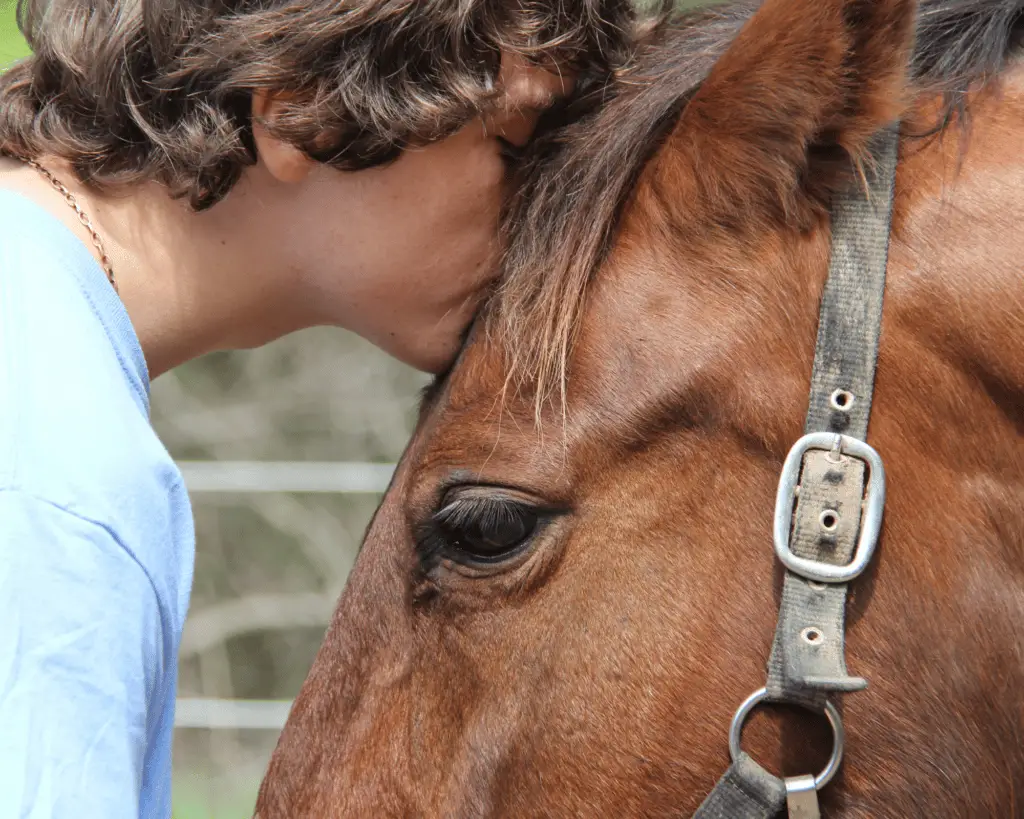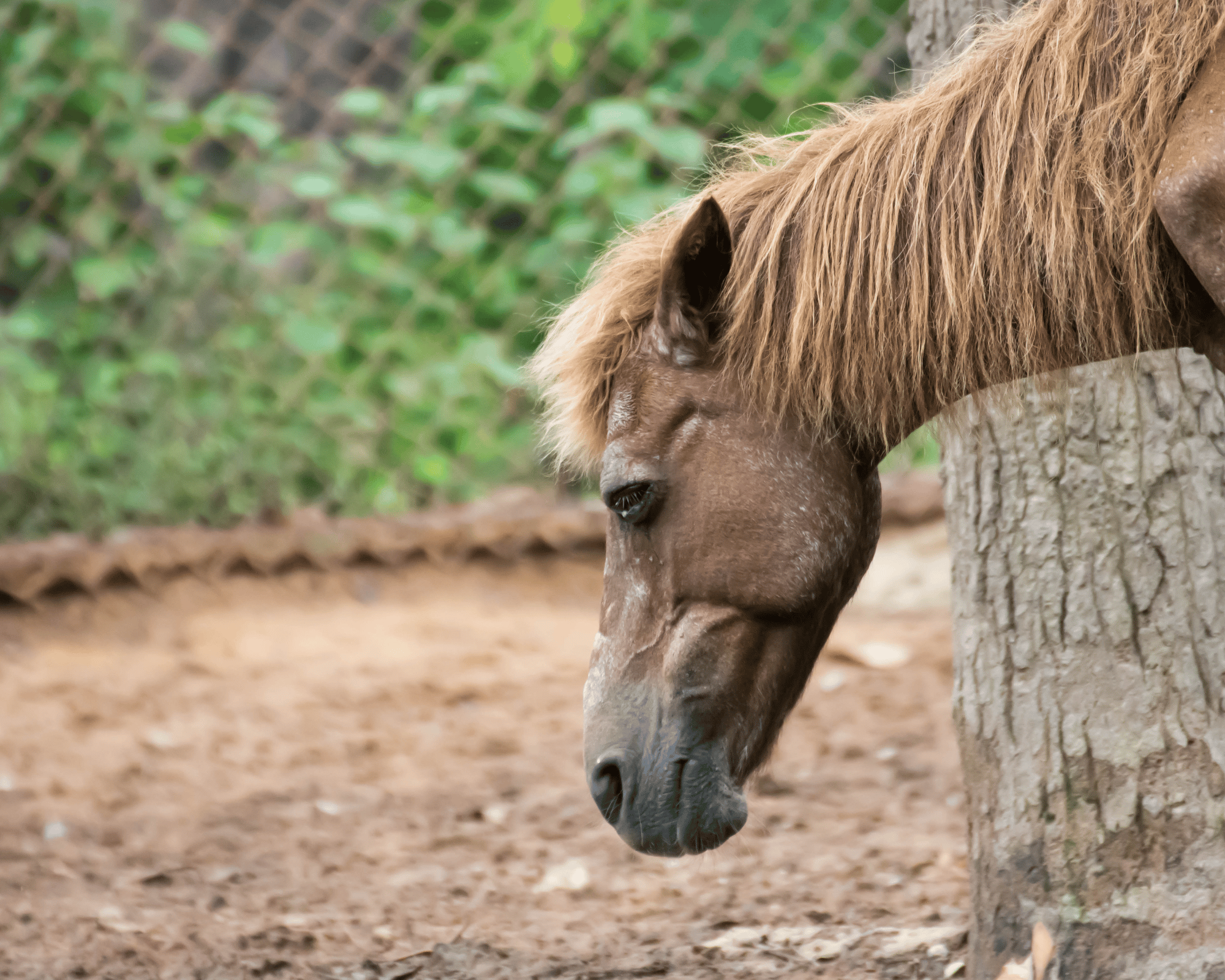Cushing’s Disease is the result of an improperly functioning pituitary gland found at the base of a horse’s brain. It’s primarily seen in older horses and ponies, but it can arise in horses of all ages. The disease is not preventable, but it is treatable and a horse with Cushing’s can live a long life with proper care. Unfortunately, there comes a point in a horse’s life where the late stages of Cushing’s disease decrease its quality of life, and euthanasia may be necessary.
A diagnosis of Cushing’s Disease is not necessarily a death sentence for a horse or pony, but it does require more attention to its diet and care. A common medication goes a long way towards extending the lifespan of a horse with Cushing’s and keeps them comfortable. It comes down to knowing when to keep treating your horse and when to euthanize a horse with Cushing’s and end their suffering.
You should always work with your veterinarian when your horse is sick, but it’s helpful to become aware of your horse’s illness so that you can do your part in caring for them. Read on to learn more about Cushing’s and how you can maintain your horse after diagnosis.
What is Cushing’s Disease?
Cushing’s Disease, or pituitary pars intermedia dysfunction (PPID) is a hormonal condition that results in metabolic changes in the horse’s body. It’s comparable to diabetes in humans as both are diseases that involve insulin resistance. The difference is that both people and horses can get Cushing’s Disease, but only people can develop diabetes as a result of Cushing’s Disease. A horse with Cushing’s is sometimes referred to as Cushingoid.
Cushing’s is most often seen in horses that are reaching their later years. A horse that’s predisposed to Cushing’s will start showing signs around the time it reaches 15 years of age and older, but it can affect horses at any stage of life. Genetics is also thought to play a role as some breeds are predisposed to developing Cushing’s. Ponies are most likely to develop PPID, but Morgans, Arabians, Paso Finos, Saddlebreds, and Quarter Horses are among the breeds most likely to be impacted by PPID.
It’s unknown what causes a horse to develop Cushing’s Disease, but the physical mechanism is known and documented. The aging process is implicated in the formation of a tumor or enlargement in a specific part of the pituitary gland known as the pars intermedia. The enlargement of the area results in the production of excess hormones that control many of the body’s functions. The pattern of inflammation is different in each horse and can result in two confirmed Cushingoid horses showing entirely different symptoms from each other.
PPID stops the production of dopamine, an essential hormone that meters hormone production. The disruption of dopamine production results in hormones flowing around the horse’s body unchecked. The excess hormones result in various disorders that affect the ability of the horse’s body to regulate itself. This results in the classic signs of Cushing’s Disease that include a long, curly coat and laminitis.
Signs and Symptoms of Cushing’s Disease

The most well-known sign of a horse that’s developing Cushing’s Disease is the appearance of a long and curly winter coat that takes a long time to shed. This is usually preceded by a few winters of a long hair coat that seems like it takes forever to shed. Once the coat becomes curly, it’s a simple matter of getting a blood panel drawn by a vet to confirm Cushing’s.
The clinical signs of Cushing’s Disease include:
- Lethargy
- Weight loss, especially if a horse was overweight prior to onset
- Increased drinking
- Increased urination
- Frequent sweating
- Glucose intolerance
- Chronic infections
- Muscle loss and/or weakness
These signs align with diabetes in humans, which is why it’s sometimes called equine diabetes. However, horses have their own version of diabetes known as Peripheral Cushingoid Syndrome or Equine Metabolic Syndrome, which does not involve the pituitary gland.
Another common sign of Cushing’s is laminitis, which is inflammation and/or damage of the tissue between the hoof and the underlying bone. It’s estimated that over 50% of all horses with a Cushing’s diagnosis are also laminitic. There are theories as to why Cushing’s causes laminitis, but the firmest link has to do with insulin resistance and high levels of blood sugar. Laminitis is the result of metabolic upset caused by too much sugar in the digestive system.
A horse that is Cushingoid is also insulin resistant and is more prone to increased blood sugar levels. When a Cushingoid horse suffers from high blood sugar levels for a sufficient period of time, it can enter into a laminitic state. A horse with Cushing’s Disease can also develop chronic laminitis as a result of the metabolic disorder. You may not notice your horse going through an episode of laminitis because the disruption is subtle and difficult to detect. It’s a good idea to monitor the state of your horse’s hooves and get a baseline for normal and abnormal states.

How Long Can a Horse Live With Cushing’s Disease?
The lifespan of a horse with Cushing’s varies from individual to individual. When PPID is identified and treated, a horse may be able to live a normal lifespan and stay healthy. In some cases, a horse doesn’t respond well to treatment and goes through a slow decline in terms of quality of life. It’s estimated that a horse lives anywhere from five to seven years post-diagnosis, but many horses have managed to live for longer than that and reach their old age.
Treating Cushing’s With Supplements and Medication
The most common and effective treatment for Cushing’s Disease is a medication known as pergolide mesylate, or pergolide for short. Pergolide is available through your veterinarian and you’ll be advised on dosage and treatment frequency once your horse has been confirmed to be Cushingoid.
Cushing’s Disease isn’t necessarily a painful condition, but an episode of laminitis can require the use of phenylbutazone for pain management. This can be detrimental to the overall health of a Cushingoid horse as phenylbutazone is known to harm the digestive system. Avoiding the use of this analgesic allows the Cushingoid horse to get the most out of its feed and can improve its response to treatment. Adding dietary magnesium and chromium to a horse’s diet can help lower insulin resistance and reduce the potential for a bout of laminitis.
Again, you should not try to treat your Cushingoid horse on your own and should always work with your vet.
The Importance of Diet in Treating Cushing’s Disease
The most effective way to treat PPID is through diet. Feeding a diet that’s low in sugar is key to helping a Cushingoid horse maintain its quality of life. Make it a point to provide hard feed with a low glycemic index in order to provide the required nutrients while reducing sugar intake. Adding a cup of vegetable or corn oil over its food provides them with safe calories that are easily digested. Dietary oil also provides a horse with a source of energy that’s derived from fats instead of sugar.
Horses that are pastured are at increased risk of laminitis during the spring when the grass has its highest sugar content. If possible, keep your horse off the pasture or put on a grazing muzzle that restricts its intake. When feeding hay, make sure to buy low-quality hay that has the least amount of sugar content, yet is still palatable for your horse to eat. This ensures your horse gets the necessary amount of fiber without the additional sugar.
If you’re unsure about the correct diet for your horse with PPID, consult with your veterinarian. They can provide you with a nutrition plan based on your horse’s blood panel results and local forage conditions.
Can You Ride a Horse With Cushings?
Yes, you can ride a horse with Cushing’s, although you may not ride them as frequently due to other conditions such as age or Cushing’s-related conditions such as laminitis. A Cushingoid horse can benefit from regular riding and also tolerate the activity with no ill effects. In fact, the vet may recommend that a horse with Cushing’s be ridden regularly to help ameliorate the conditions caused by unbalanced hormones. Exercise has the benefit of burning off excess hormones and getting the horse to a more optimized level of hormones and physical function.
Always consult with your vet prior to riding a Cushingoid horse. There may be other complicating factors that require you to reduce the amount of activity your horse can handle.
What Happens When You Don’t Treat a Horse With Cushing’s Disease
As previously mentioned, a horse with PPID is living with an unchecked flow of hormones throughout its body. The conditions that form as a result of unchecked hormones are ones that cause a horse to age faster. A Cushingoid horse is more prone to developing a chronic infection or suffering from chronic laminitis that affects its ability to survive.
The late stages of Cushing’s in horses become visible in the horse’s body condition and frequency of bouts of laminitis. The horse’s coat starts looking dull, energy levels are almost non-existent, there’s little to no fat covering the topline, and the horse may be suffering from increasingly severe laminitis.
When a horse with Cushing’s stops responding to treatment or has chronic laminitis, it’s time to consider euthanasia and allow them to pass before they get worse.
Always consult your veterinarian about letting your horse go. The vet is an impartial judge and can advise you on what’s to come for your horse if you decide not to euthanize it at that time. Whatever your final decision may be, you can take comfort in knowing that you did what you could to keep your horse comfortable and provide them with a good life before its condition overtook its body.
Sources:
https://pubmed.ncbi.nlm.nih.gov/11591169/
https://pubmed.ncbi.nlm.nih.gov/15635908/


Brilliant and very informative.My shetland pony was put to sleep on the vet’s recommendation.She was extremely lethargic with regular bouts of laminitis.I was heartbroken.She was such an adorable pony with an incredibly pretty face and very sweet nature.I desperately wanted her to stay,but she was struggling.This information about cushings was very helpful for me.Thankyou
Dear Paula, it’s so difficult to let them go… My vet tech said these words …. The kindest thing you can do for your friend is to let him go …. She was so right …. They try so hard for us … letting them go I believe is how we respect them enough to end their struggle and pain.
Thank you for the article and the helpful information. Currently treating 2 horses with Cushing’s, and it is very hard to know when to let go. This article has given me some good guidelines to make the decision more clear.